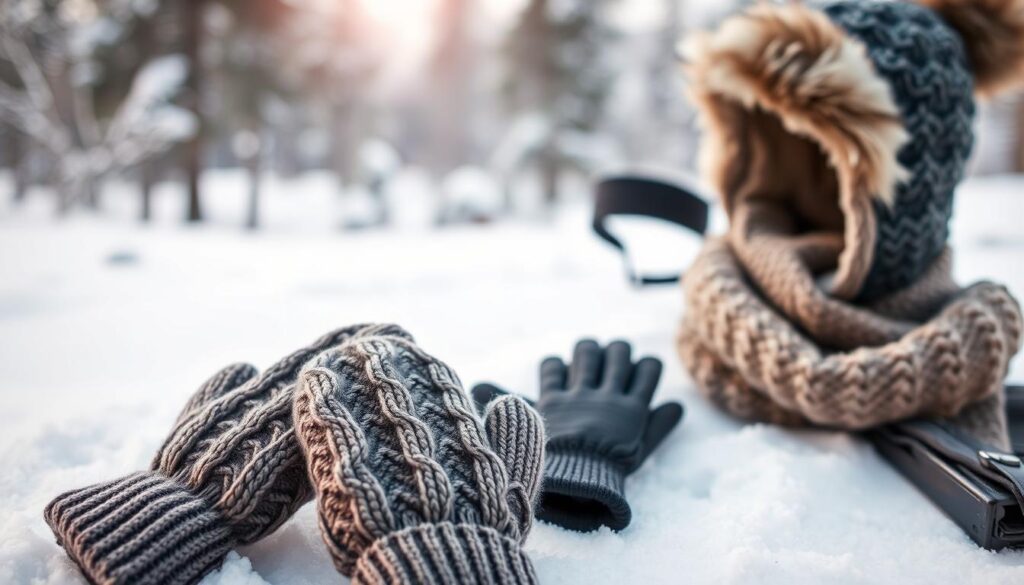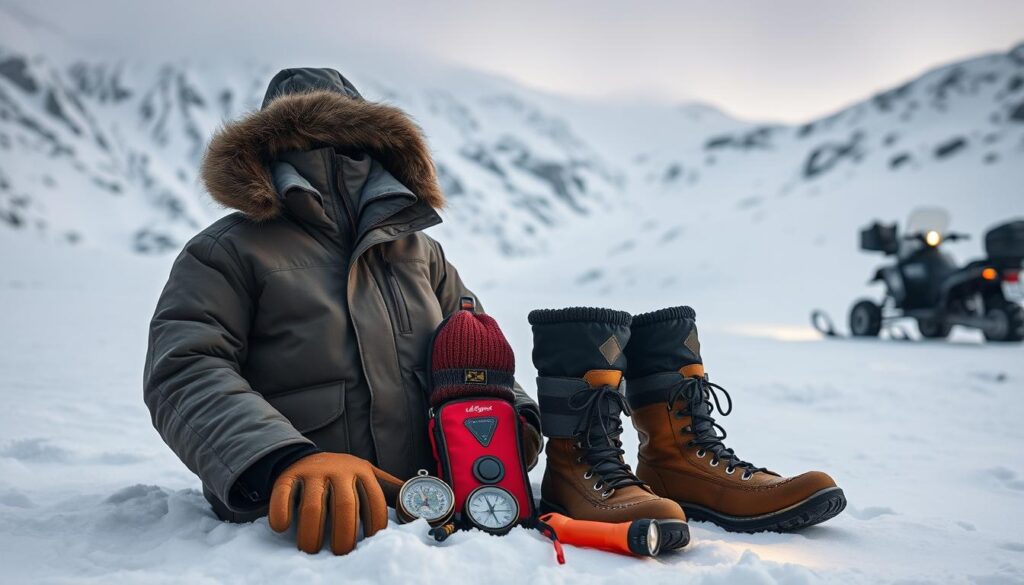Essential Cold Weather Gear for Every Adventure
The wind hit my face during a winter mountain trip. I learned survival depends on your gear. Every breath was hard, showing how tough winter can be without the right stuff.
Winter adventures need more than bravery. Your clothes are a key defense against the cold. Whether hiking, skiing, or exploring, the right gear makes it exciting.
Good winter gear is a must, not a luxury. Knowing how to stay warm in extreme cold is key. Experienced adventurers say quality gear is an investment in safety and comfort, not just a cost.
Table of Contents
Understanding Winter Layering Systems
When you go out in the cold, what you wear matters a lot. The right clothes can keep you warm and comfortable. It’s all about layering to beat the cold.
Thermal underwear is key to a good winter outfit. It regulates moisture, provides insulation, and shields against wind and rain.
Key Base Layer Features for Effective Sweat Control
A good base layer is essential for preserving your body’s warmth in cold conditions. Pick clothes that pull sweat away from your skin:
- Merino wool for natural temperature regulation
- Synthetic fabrics for quick-drying performance
- Compression fit to minimize moisture retention
Insulating Mid-Layers for Temperature Control
Mid-layers with fleece keep you warm by trapping air. They serve as a protective shield from freezing temperatures.
| Material | Warmth Rating | Best Use |
|---|---|---|
| Fleece | High | Active winter sports |
| Down | Extreme | Cold, dry environments |
| Synthetic Insulation | Moderate | Wet conditions |
Outer Shell Protection Against Elements
The outer layer should guard you against wind, precipitation, and snow. Choose something waterproof and breathable. It should let moisture out but keep rain and snow out.
Pro tip: Always test your layering system before going out. Ensure it fits comfortably and offers a good range of motion.
Critical Cold Weather Gear for Safety and Comfort
Surviving winter adventures needs careful gear choice. Your safety and comfort depend on the right winter jackets and protective gear. This gear must handle extreme cold well.
For cold weather trips, focus on key gear parts:
- High-performance winter jackets with top insulation
- Waterproof and insulated boots for tough terrain
- Advanced protective accessories
Choosing the best winter jackets is key to keeping warm. Look for ones with synthetic or down insulation. Brands like Rab and Arc’teryx offer great protection against harsh winter.
Your boots are vital in winter survival. Insulated boots keep feet warm and prevent injuries. Choose boots with:
- Waterproof exterior materials
- Thick insulation layers
- Robust traction systems
Brands like Oboz and Sorel make insulated boots for extreme cold and tough terrain. Investing in reliable winter gear enhances your safety during harsh conditions.
“The right equipment can turn a risky winter outing into a safe and pleasant adventure.”
Layering and picking the right gear are crucial for winter safety. Your gear should be versatile, durable, and made for tough conditions.
Winter Footwear and Protection
Keeping your feet warm in winter needs the right gear. You must pick insulated boots, protective layers, and moisture-managing accessories. This ensures your comfort and safety.
Choosing the right winter shoes is more than just staying warm. You need gear that tackles many cold-weather challenges.
Insulated Boots for Snow and Ice
Insulated boots are your first defense against cold. Look for these features when picking boots:
- Waterproof exterior materials
- Thick thermal insulation
- Robust traction soles
- Comfortable fit with room for thick socks
Gaiters and Waterproof Protection
Gaiters protect your lower legs and boots. They keep snow out and add a moisture barrier.
- Coverage from ankle to mid-calf
- Elastic or adjustable straps
- Reinforced bottom edges
Specialized Socks for Cold Conditions
Your sock choice affects foot comfort in winter. Snow pants and the right socks keep you warm and dry.
- Merino wool blends
- Moisture-wicking materials
- Padded heel and toe areas
- Compression zones for circulation
Quality winter footwear keeps you warm, dry, and comfortable. It’s key for your coldest outdoor adventures.
Essential Headwear and Hand Protection

Keeping your head and hands warm is key in extreme cold. Your hands and head are most at risk from freezing. So, choosing the right gear is vital for staying safe and warm outside in winter.
Here are some important items to consider:
- A high-quality balaclava for complete face and neck coverage
- Heated gloves designed for extreme temperatures
- Insulated hats with wind-resistant materials
- Moisture-wicking inner glove layers
A balaclava is great for keeping your face and neck warm. It covers everything except your eyes. Look for ones made from advanced thermal fabrics that keep you warm and let moisture out.
Heated gloves are a big deal for winter lovers. They use batteries to keep your hands warm in freezing weather. Those who spend extended time outdoors in freezing temperatures rely on this gear to prevent frostbite and maintain mobility.
“Protecting your hands and head properly can determine whether your winter experience is safe or hazardous.”
When picking your winter gear, look for:
- Thermal insulation
- Moisture management
- Wind resistance
- Flexibility and mobility
Invest in good balaclavas and heated gloves for your winter adventures. Appropriate equipment is your strongest protection against extreme winter conditions.
Sleep Systems for Winter Camping
Winter camping requires special gear to stay warm and safe. Your sleep system is key for comfort and survival in the cold. Choosing the right gear can make your camping trip enjoyable or a bad experience.
- Four-season tents
- Cold-rated sleeping bags
- Insulated sleeping pads
Four-Season Tent Selection
Your tent must protect you from harsh winter weather. Look for tents with:
- Strong aluminum or carbon fiber poles
- Steep walls to shed snow
- Good rainfly coverage
- Little mesh for wind protection
Sleeping Bag Temperature Ratings
Choose a sleeping bag designed for temperatures at least 10 degrees below your expected minimum. This ensures you stay warm on cold nights.
| Temperature Rating | Recommended Usage | Insulation Type |
|---|---|---|
| 0°F to 15°F | Winter Mountaineering | Goose Down |
| 15°F to 30°F | Winter Camping | Synthetic/Down Blend |
| 30°F to 50°F | Three-Season Camping | Synthetic |
Insulated Sleeping Pad Considerations
An insulated sleeping pad stops heat from escaping to the ground. During cold-weather adventures, opt for a sleeping pad with an R-value from 4 to 6 for better insulation. Closed-cell foam or inflatable pads with synthetic insulation are best for cold weather.
Snow Travel and Navigation Equipment
Navigating snowy terrain needs special winter clothes and gear. The right equipment can make your adventure safe and successful. Your snow travel gear must be chosen carefully for safety and ease in winter conditions.
Key snow travel tools include:
- Snowshoes for moving through deep snow
- Lightweight crampons for icy paths
- Backcountry skis for easy wilderness travel
Navigation is key in winter. Good tools help you stay on track and avoid danger. A GPS with long battery life is essential. However, it’s essential to bring printed maps as a backup.
Experts say to have many navigation tools:
- Handheld GPS device
- Topographic maps in a waterproof case
- Compass with declination adjustment
- Satellite communication device
Your winter clothes should have lightweight, useful navigation gear. This gear should be compact and durable. It helps you face unexpected challenges in snowy areas.
Winter Cooking and Hydration Systems
Surviving winter outdoor adventures needs careful planning for cooking and staying hydrated. The right equipment can greatly influence both your comfort and safety outdoors. Cold weather demands special equipment to keep you nourished and hydrated.
When preparing for winter, choose the best cooking and hydration gear for freezing temperatures. Hand warmers are key to keeping your equipment working.
Cold Weather Stoves and Fuel
Finding the right stove for winter is essential. Your cooking system must work well in cold:
- Liquid fuel stoves perform better in cold
- Canister stoves with winter-specific adaptations
- Integrated windscreen designs
Insulated Water Storage Solutions
Keeping water from freezing is crucial in winter. Insulated water containers with special designs help:
| Water Storage Type | Insulation Feature | Temperature Range |
|---|---|---|
| Expedition Bottles | Thick Neoprene Coating | Down to 0°F |
| Vacuum-Sealed Containers | Double-Wall Insulation | Down to -20°F |
| Hydration Pack Insulators | Thermal Sleeve | Down to 10°F |
High-Energy Food Requirements
Winter activities need more calories. Choose nutrient-dense foods for energy and warmth. Hand warmers can help maintain your body heat and keep your meals from getting cold.
- High-fat protein bars
- Dehydrated meal packages
- Nuts and dried fruits
- Chocolate and energy gels
Preparing your cooking and hydration systems well ensures you stay warm, fed, and hydrated in winter.
Emergency and Safety Equipment

When you head into cold places, being ready for surprises is key. Proper gear can be life-saving—it’s often what separates a minor issue from a serious threat.
Winter trips need the right safety items. These include:
- First aid kit with cold-weather specific supplies
- Emergency communication devices
- Avalanche safety equipment
- Portable shelter
- Hand warmers for critical temperature management
Devices like satellite phones and emergency beacons are essential for remote wilderness communication. They help you call for help when phones don’t work. Hand warmers help maintain dexterity and warmth when operating devices in freezing weather.
Avalanche safety needs special gear for dangerous areas. Your kit should have:
- Avalanche beacon
- Collapsible probe
- Lightweight rescue shovel
- Extra hand warmers for rescue situations
Choose emergency gear that’s light and does many things. Hand warmers are small but can save you from cold dangers.
“In wilderness emergencies, preparedness isn’t just an advantage—it’s a lifeline.”
Test your emergency gear before winter trips. Familiarize yourself with using these tools in both cold temperatures and high-pressure situations.
Conclusion: Investing in Quality Cold Weather Gear
Choosing the right cold weather gear can make winter adventures amazing. High-quality gear keeps you safe, comfortable, and happy outdoors. Experts know that good gear is a must, not just a luxury.
Look for gear that’s durable, performs well, and keeps you safe in cold. Top brands such as The North Face, Patagonia, and Arc’teryx offer reliable gear designed to keep you warm and dry in harsh environments.
Investing in quality gear is crucial to staying safe and making the most of your outdoor experience. Find the right gear for your winter activities, like skiing or hiking. Good choices help you avoid dangers and enjoy the winter scenery.
Knowing how important good gear is, you’ll be ready for winter. Each item protects you from the cold and wet. Choosing the right gear means you’ll have a great time exploring in the winter.

